Part of the state-run Alaska Marine Highway System, the Hubbard serves as one of the only connections between coastal communities in the region. And as one of two roundtrip ferry stops scheduled for that month, its arrival sparked a flow of activity. Parka-clad adults and teenagers streamed off the ferry. A large U.S. Forest Service SUV, stuffed to the brim with Costco supplies, lumbered over the grate and idled in the snow-dusted lot ahead of our similarly packed Subaru.
While directing the flood of newcomers, Angoon School Principal Emma Demmert stepped next to our car and exchanged greetings. “Head to the gym, there’s a game tonight,” she said before moving on to the next car in line. Soon, vans, trucks, and a school bus were filled up and heading north.
Three miles down the road, on a narrow peninsula between Chatham Strait and Kootznoowoo Inlet, is most of Angoon proper. The only community on Admiralty Island — in Lingít, Kootznoowoo, meaning the fortress of the bears — Angoon, or Xutsnoowú Kwáan, is surrounded by nearly 1 million acres of protected Wilderness. Angoon’s first people chose a townsite with access to strong tides, fresh kelp, bountiful creeks, and thick forests. But the clan houses that stand tall in the center of town, looking out toward the mountains across the strait, are more recent. In 1882, the U.S. Navy destroyed the entire village of Angoon over disagreements about a Lingít shaman’s death aboard a whaling ship. Left with only one canoe, many Lingít died in the months following the attack. Those who survived rebuilt the community in the decades afterwards, without assistance or apologies from the U.S. government.
Nearly 150 years later, Angoon’s residents carry forward their rich cultural traditions and communal values while holding tight to their history. From harvesting regionally renowned black seaweed and holding generous potlatches to playing packed basketball tournaments and reviving Lingít language use, Angoon is shoring up their resilience once again. The village’s year-round population declined to 350 residents in 2020, almost half of what it was in 2000, reflecting similar trends around the state. A history of residential boarding schools removing young generations from communities was replaced with under-funded local schools. Chronic state budget shortfalls led to disinvestment in rural infrastructure. This deficit, visible in the ferry system’s slashed schedule, has also pushed up the price of energy in Angoon and many other villages throughout the state.

The sun sets on the MV Hubbard on the way from Juneau to Angoon. Photo by Jenny Starrs/REAP.
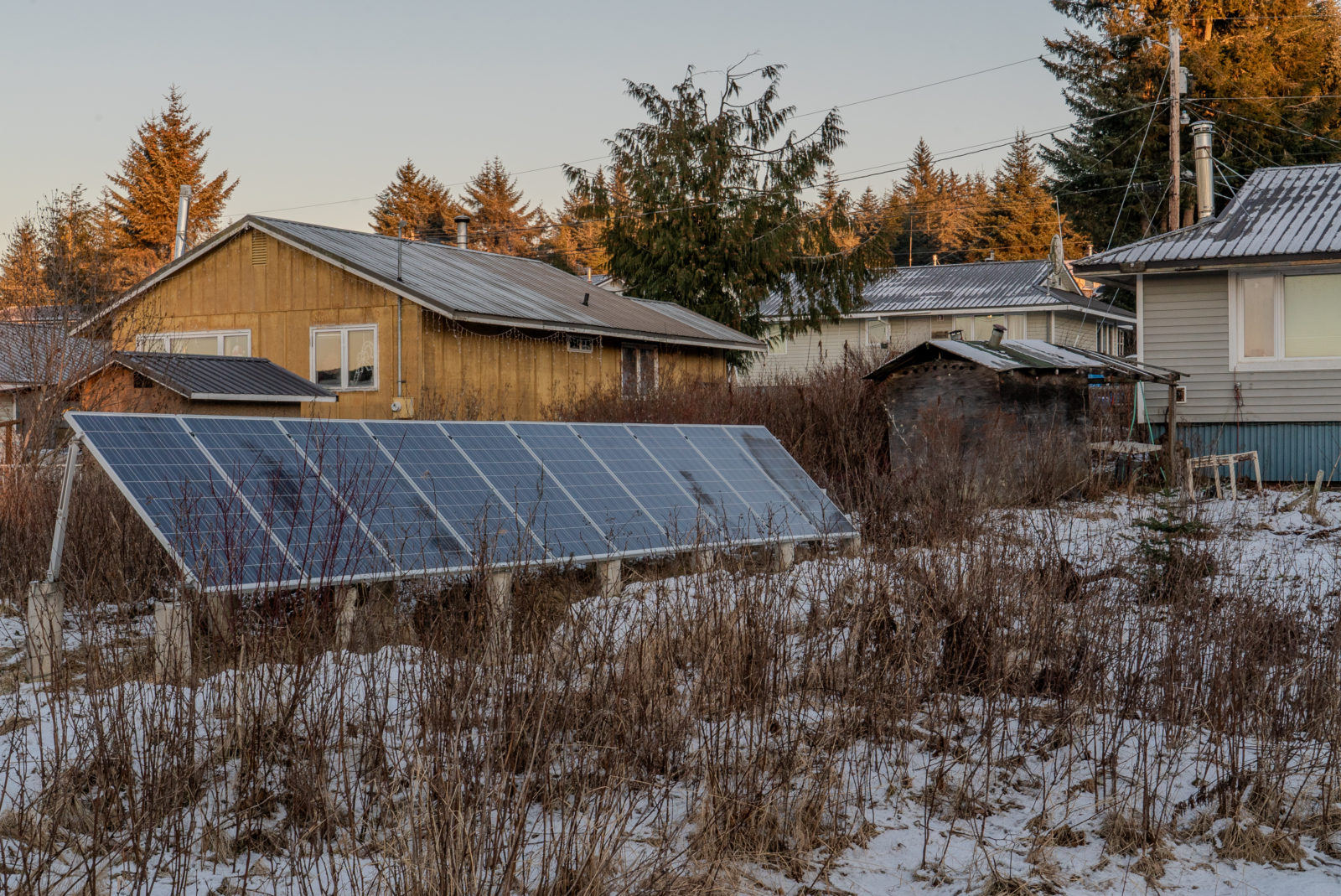
Solar panels in Angoon capture the fleeting winter sunshine. Photo by Jenny Starrs/REAP.
The Precipice of Change
Like many remote communities in Alaska, Angoon runs on diesel. Its powerplant and fuel tanks sit near the middle of town, humming along to power residents’ lights and appliances, the school’s hydroponics and smart boards, and the clinic’s medical equipment at a cost of about $0.50 per kilowatt-hour. The state’s Power Cost Equalization program brings down residential electricity rates to $0.39/kWh—double the rates in many nearby communities—but it doesn’t apply to businesses or facilities like the school or clinic. Without affordable local electricity generation, Angoon’s energy security and economic opportunity has suffered from a reliance on the fluctuating prices of yearly fuel deliveries.
Angoon’s energy economy is on the precipice of big changes however. Kootznoowoo Inc., Angoon’s Alaska Native Village Corporation, was awarded $26.9 million in February 2024 to build a run-of-river hydroelectric facility and transmission line at Thayer Creek, or Watkesate’, meaning stream with rock in its mouth. The funding came more than 40 years after the Alaska National Interest Lands Conservation Act preserved the community’s right to develop the project, without the funds to build it. Thayer Creek holds the key to a more resilient and sustainable economy in Angoon: Legacy hydropower facilities in Southeast Alaska produce the cheapest electricity in the state, at about $0.14/kWh in Juneau.
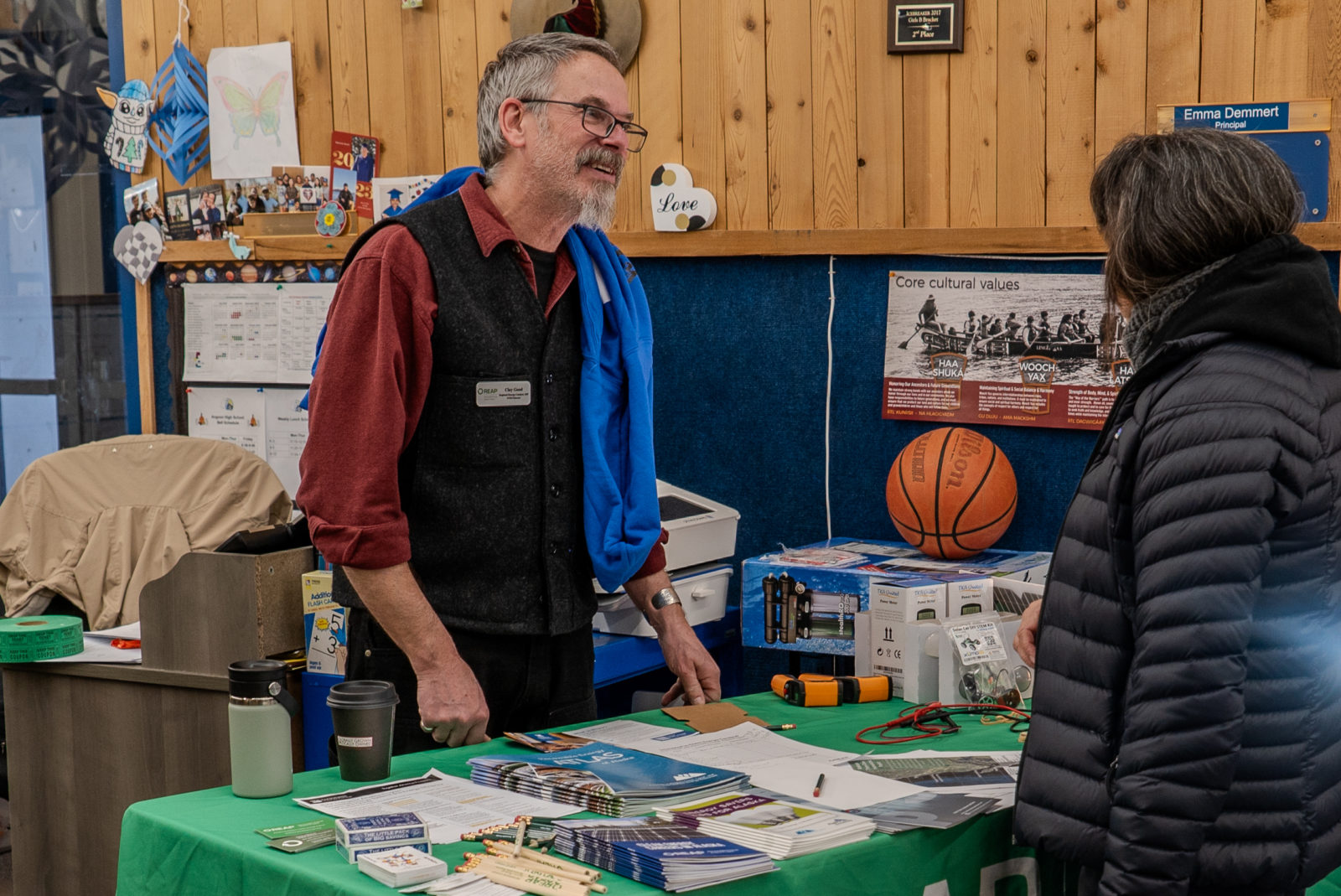
REAP educator and SSP energy catalyst Clay Good speaks to a community member at the Angoon career fair. Photo by Jenny Starrs/REAP.
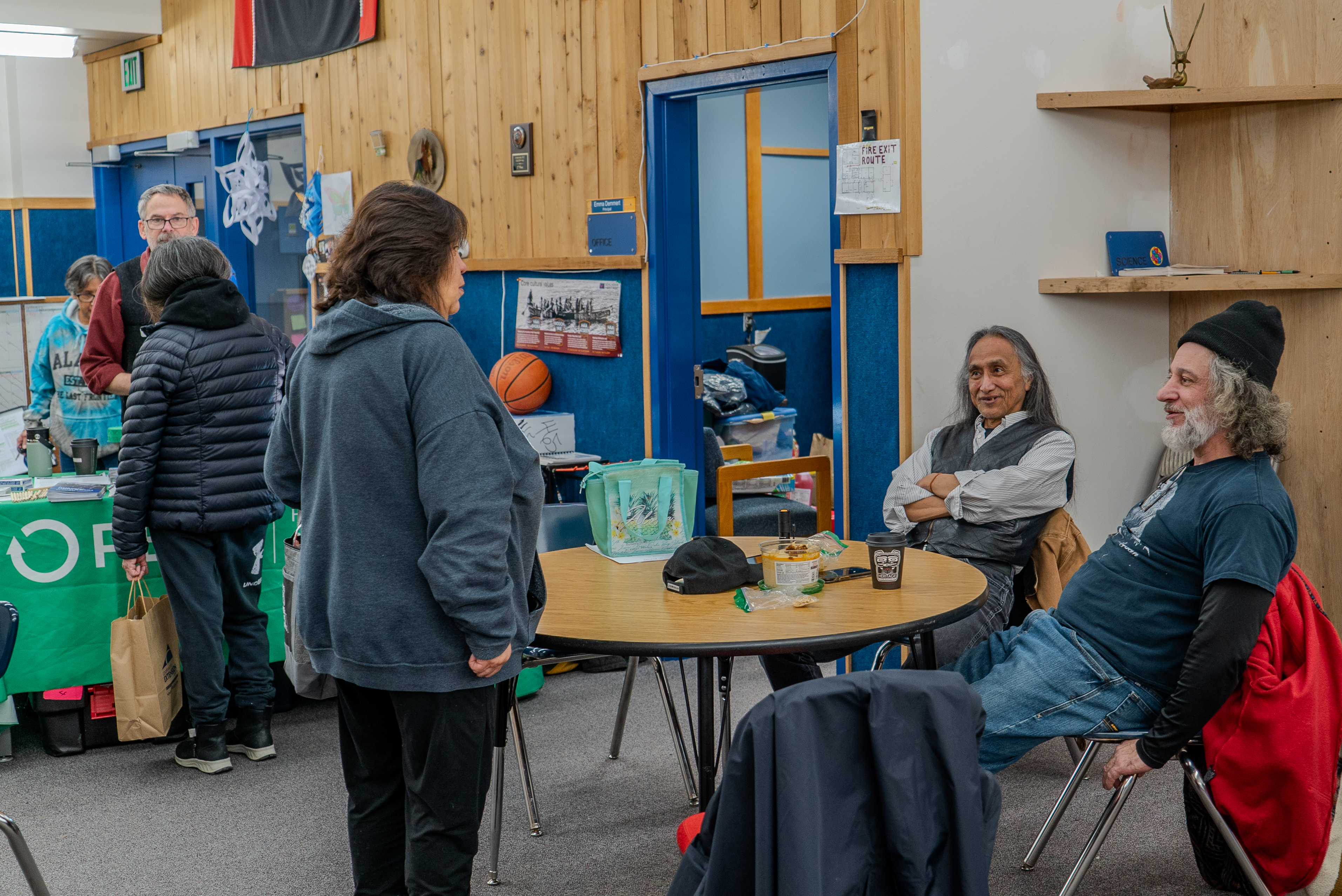
Culture bearers John Smith III (right) and Tommy Jimmy Jr. (center) traveled from Juneau to Angoon for the career fair. Photo by Jenny Starrs/REAP.
When Kootznoowoo Inc. and its contractor DeerStone Consulting secured the permits for the project in 2023, they contacted REAP educator and SSP regional energy catalyst Clay Good. With a beach landing site that needed heritage mapping and an access road that needed flagging, they wondered: Could students in the area get involved?
Soon, a diverse group of individuals and institutions from Angoon to Anchorage began to wooch.een, or work together, for the community’s cultural, economic, and ecological resilience. Good’s role straddles both the nonprofit organization Renewable Energy Alaska Project (REAP) and the collective impact network Sustainable Southeast Partnership (SSP). Through his work, he connected with regional and local education leaders, including Principal Demmert, counselor Frank Coenraad, superintendent Ralph Watkins, Alaska Youth Stewards crew lead Eric Benedict, SSP workforce catalyst Michael Mausbach, SSP youth catalyst Gabe Sjoberg, University of Alaska horticulture agent Darren Snyder, U.S. Forest Service program administrator Josh Orem, and culture bearers Victoria Johnson, Tommy Jimmy Jr., and John Smith III.
Planning calls became regular and a wide-ranging committee formed, thinking beyond current job needs and more expansively of pathways to sustainable careers in Angoon. The school held a job fair in the spring of 2023, leading to 20 students landing summer jobs in Angoon with organizations like Alaska Youth Stewards and Southeast Alaska Expeditions. Next up was a community career fair to show all the possibilities beyond summer jobs.
Supporting Angoon’s Youth: Basketball and Resume Building
In true Southeast Alaska fashion, Angoon’s first annual community career fair was a meld of collaborative planning, scrappy resourcefulness, and good fortune. Just like many aspects of life in the region, the ferry dictated the scheduling. With so few winter trips to Angoon, that led to the first stroke of luck: The village’s first annual Senator Kookesh Invitational basketball tournament, organized in honor of former state legislator Albert Kookesh by his daughter, Angoon School’s Lingít language teacher Chenara Johnson, was slated for the same time.
The tournament brought in teams from Hoonah and Kake, tripling the high schoolers who could attend the career fair and creating an extra draw for the community to attend. Before the other teams arrived, and before low temperatures canceled flights for the week, SSP’s workforce catalyst Michael Mausbach caught one of the last float planes to Angoon. Mausbach helped Angoon’s students prepare for the career fair with resume coaching and a career readiness workshop.
After the ferry arrived, regular season games pitted the Angoon Eagles against the defending state champion Kake Thunderbirds. Well past midnight, the games wrapped up and the out-of-town teenagers transformed the high school gym into their dormitory. Adults fanned out to a Tribal fourplex, a wilderness lodge, a Salvation Army inn, friends’ houses, and a U.S. Forest Service bunkhouse.
The community career fair and tournament kicked off in full force the next day. Key participating organizations included Goldbelt Heritage Foundation, University of Alaska, Hecla Greens Creek Mine, Sealaska Heritage Institute, Southeast Alaska Watershed Coalition, Central Council of the Tlingit and Haida Indian Tribes of Alaska, Kootznoowoo Inc., and Southeast Alaska Regional Health Consortium. Their representatives discussed career pathways within Angoon and Southeast Alaska in education, construction, agriculture, forestry, wilderness guiding, and, of course, energy.
Good and myself, network coordinator for REAP’s Alaska Network for Energy Education and Employment, presented opportunities throughout the region and for the Thayer Creek hydropower project. It will create 30 construction jobs over the next decade, which can give residents hands-on experience to launch them into a host of energy careers. Electricians, heavy equipment operators and many other energy construction positions are integral to build the access road, transmission line and powerhouse for Angoon, and infrastructure investments regionwide. Then, once built, the plant will hire a full-time operator from Angoon and catalyze careers in beneficial electrification and a host of new economic opportunities.
Angoon’s first annual community career fair in January 2024, on the cusp of a transformational hydropower project more than 40 years in the making, was a joyous event that showcased partnerships from across the region. Video by Jenny Starrs/REAP.
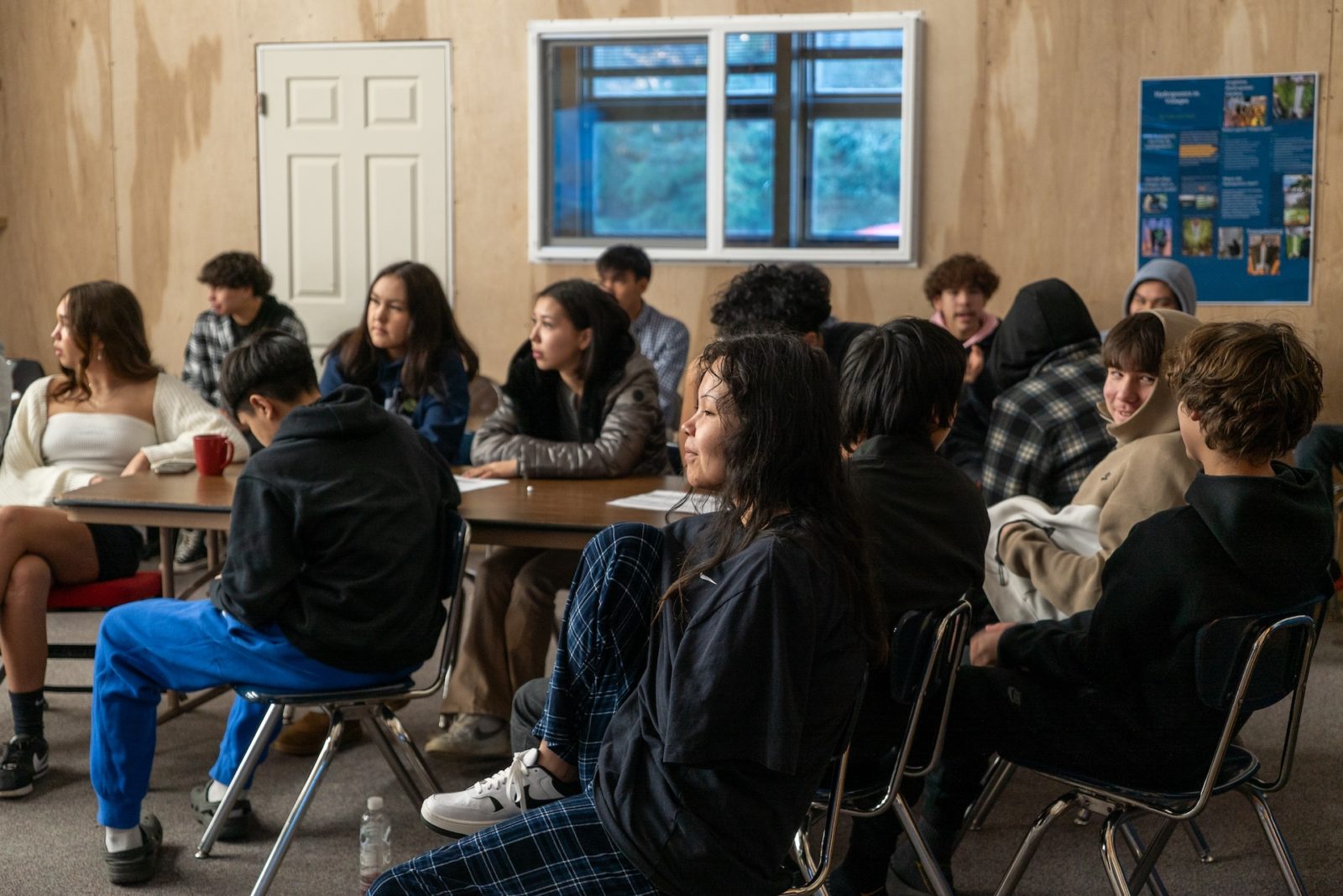
Angoon students listen to career fair presentations. Photo by Jenny Starrs/REAP.
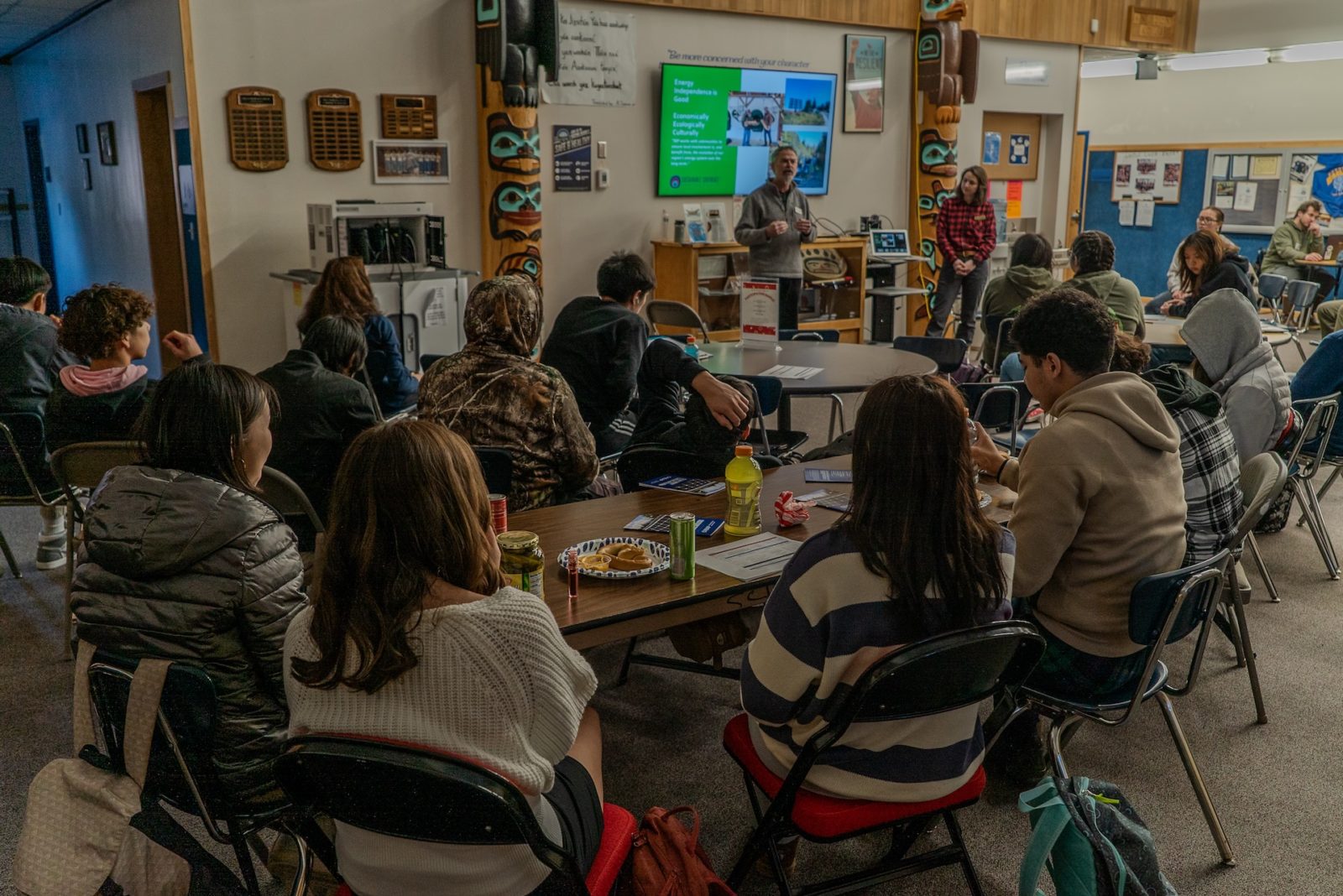
REAP staff discuss clean energy career opportunities in Angoon. Photo by Michael Mausbach/SSP.
A Community Comes Together
During an evening break in the tournament schedule, the community gathered for a potlatch. The canceled seaplanes left organizers short 30 pizzas, lending an anxious air to the final flurries of cooking. But pots and platters piled up as culture bearers drummed and community members arrived. Delicacies saved from summer’s bounty, including fish head soup and black seaweed fried rice, joined containers of fruit casserole and homemade spaghetti to feed the crowd.
Basketball players delivered plates to elders and then dug into their own meals. Elder Peter Demmert instructed me where to find the best meat on a fish head as his niece, Principal Demmert, dished out rolls from an overflowing 5-gallon pail. Organizers led a community cafe-style discussion interwoven with Lingít stories of Raven and Eagle, and Mayor Peter Duncan, dressed in his referee uniform, shared his vision for Angoon’s future. Then, as teens readied for their next game, the crowd danced together, swaying “like the kelp,” as one elder described.

The Angoon Eagles won second place in the boys’ tournament and third in the girls’. Photo by Jenny Starrs/REAP.

SSP catalysts Gabe Sjoberg and Clay Good and career fair leader Josh Orem help load wood to transport to elders in Angoon. Photo by Jenny Starrs/REAP.
The final day of the career fair brought a carnival-like atmosphere. Visitors set up tables in the high school commons while enterprising high schooler Luke Jack poured lattes and another student pressed custom tournament sweatshirts. Soon, dozens of community members and students were making the rounds, scoring swag and door prize tickets at each table. Pairs tried out heavy equipment operator simulators, parents discussed Cooperative Extension materials, and kids played with hand-crank flashlights and solar cars. Elders posted up with coffee and snacks at the heart of the fair until the basketball tournament took center stage.
With snow steadily falling and daylight fading, career fair participants pitched in with a final task for Angoon. Earlier in the season, the boys’ basketball team had split firewood as a fundraiser. Wood stoves heat many of the older homes in Angoon. They are a reprieve from high electricity and fuel prices, but only as long as a household can chop and move their own firewood—making the deliveries a lifeline for elders and their families.
Unseasonably cold weather was visiting Angoon along with the out-of-town guests, and some elders’ wood piles were exhausted. It was time to once again wooch.een. Teammates, teachers, and visitors handed off piece after piece of firewood, assembly line style. Stick by stick, foot by foot, the younger generations filled the truck bed, then drove off into the snow storm to deliver warmth and comfort to their elders. The endeavor required creativity, collaboration, and determination—just like the hydropower project, the potlatch, and the path to charting a self-determined, sustainable energy future for Angoon. The clean energy transition will change the trajectory of rural Alaskan communities. And as long as young people are at the forefront to dream and build what their communities will look like in the decades to come, the future will be bright.
Community Voice: Angoon School Principal Emma Demmert
Written by Emma Demmert
One of my goals for the school and for our students is to help them figure out what they want to do when they get out of high school by exposing them to as many opportunities as possible. The Angoon Career Fair is one of the ways we serve not only our students, but the whole community, by sharing about job opportunities and career pathways that are out there, what it takes to pursue those, what skills they are going to need, and what they need to do to get into positions available right here in Angoon. We can help by tailoring their education towards those career pathways, based on their interest.
Angoon is a special community because there are so many entities and partnerships working together here for the good of all the community members. By exposing students to job opportunities that are not only available, but that are important for the community, like in renewable energy or land stewardship, we hope that students can see themselves building a healthy future here beyond high school.
The recently announced $27 million federal investment into Angoon’s long sought-after hydro project is going to open doors for these students. We want them to not only be part of the construction and engineering of this project, but to be thinking creatively about what types of businesses they want to build in a community with more affordable energy: things like starting a second-hand clothing shop, running a drive-through coffee stand, or selling locally made artisan products like devil’s club salve and fireweed jelly. The future is bright in Angoon and our young people are at the cusp of innovation.

Principal Demmert was the driving force behind Angoon’s community career fair. Photo by Jenny Starrs/REAP.
Credits and Publications
Writing and editing contributed by Clay Good. Header photo by Lee House/SSP. Editing, layout, and production by Bethany Goodrich/SSP.
Gunalchéesh to the entire Angoon community and the Angoon Career Fair and Job Fair Committees.
Story published in the Juneau Empire on May 8, 2024, and the SSP spring 2024 magazine, Woven.